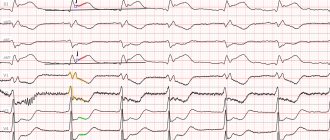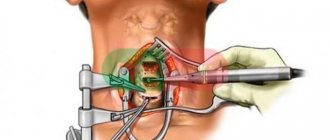Pathologies of the cardiovascular system are the most common among the disorders of the body. One of the leading positions in popularity is occupied by ectasia of the internal jugular vein; we will tell you what it is in our article. Identifying the cause of the disease will help correct its development, eliminate unpleasant symptoms and consequences that develop when the problem is ignored. Only a qualified specialist can correctly determine the original source of the disease and prescribe effective therapy.
Features of the pathology
Dilatation of the jugular vein (phlebectasia) usually occurs due to disruption of the valves located along the entire length of the vein. For one reason or another, the valves are no longer able to control venous blood flow. As a result, blood begins to accumulate in large volumes in the vessel, expanding its walls and disrupting the functioning of an increasing number of valves.
The next important factor is the discharge of blood from deep veins to superficial ones. Such an unnatural redistribution of blood provokes dysfunction in the activity of the entire venous system, which also leads to the development of vasodilation.
The jugular vein includes several branches - two internal, anterior and external. These vessels play an important role in the functioning of the body - carrying blood away from the brain and neck. The location too close to the brain forces us to take any pathologies of the jugular vein with particular seriousness.
Parkes-Weber-Rubashov syndrome
Veins can also dilate as a result of pathological arteriovenous connections and fistulas. The latter can be either congenital (this is Parkes-Weber-Rubashov syndrome) or acquired.
Fistulas in arteries and veins can be located in any organ or tissue, but most often they are detected in the extremities. The result of the disease is an increase in the cavities of the heart and the development of chronic heart failure
.
Symptoms of the pathology include dilated veins at the surface and a feeling of trembling upon palpation. Treatment of Parkes-Weber-Rubashov syndrome takes place in several stages, it all depends on the specific case. Angiosurgeons excise vessels, sometimes pathological vessels are stitched directly through the skin. Compression therapy is also necessary. In severe cases, limb amputation is indicated.
Reasons for development
It should be understood that phlebectasia of the IJV on the right does not depend on the age category of the patient; it is observed both at early and older ages.
The reasons for the development of the disease can be very different:
- cervical and head injuries, craniocerebral contusions, concussions;
- injuries to the back and spine, rib fractures, causing venous congestion;
- prolonged exposure to an uncomfortable position, work that requires a sedentary lifestyle;
- vascular and heart diseases, ischemia and high blood pressure;
- the presence of benign and malignant formations of internal organs, blood cancer;
- diseases of the spine and back muscles, when the patient takes a forced position to alleviate his condition, in particular, osteochondrosis;
- pathologies of the endocrine system.
Congenital phlebectasis
This condition is characterized by dilated and tortuous veins that closely resemble varicose veins. The disease is usually registered in the first months after the baby is born. The veins of the extremities are most often affected. Phlebectasis can change the geometry of the limb; in addition, with this disease, the skin of the diseased part of the body becomes thinner, and the skin has a bluish tint. The affected limb appears thicker
than the healthy paired limb, the patient complains of pain.
If you palpate such veins, they will easily collapse and fill with blood again. In addition to venous pathology, problems with the trophism of other tissues are usually detected, hypoplasia and slow growth of muscles and bones are recorded. When overfilled, the veins may rupture.
Phlebectasis is diagnosed using phlebography and duplex scanning. Treatment involves surgery, which is usually performed in the first years of life. Sclerotherapy is sometimes effective
.
Symptoms
Ectasia of the internal jugular vein - what is it? Initially, this disease is not accompanied by any symptoms. With a minor action factor, the pathology develops over several years without causing any symptoms.
The initial signs are a noticeable dilation of the vessel in the neck; the vessels located above form a blue pouch, and those below swell and begin to resemble a spindle. In this case, the patient does not feel any discomfort or pain.
Subsequently, a feeling of tightness in the affected area may appear, especially when moving the head or screaming loudly.
In the last stages of the disease, pain in the neck is observed, breathing becomes difficult, and the voice becomes hoarse. In this case, urgent treatment is necessary, since the presence of these symptoms has a negative impact on the overall functioning of the body.
Why is this happening
Phlebectasia disrupts the functioning of valves and blood vessels. The regulation of venous blood flow is suspended. Clots appear. With a large number of such formations, dysfunction of the entire venous network develops.
If the jugular vein is dilated even slightly, it is manifested by the following symptoms:
- swelling of the cervical vessels, their enlargement;
- the appearance of a blue sac on the upper section of the vein;
- swelling of the neck;
- a feeling of tightness that occurs when turning the head;
- breathing problems;
- pain when touching the neck;
- loss of voice.
Signs of pathology depend on the stage:
- Swelling of blood vessels in the neck. The patient does not feel any discomfort. A sign of pathology is identified during a visual examination.
- Drawing pain. The patient's intravenous pressure increases if he makes rapid and sudden head movements.
- Acute pain of high intensity. The man's voice is hoarse. Breathing is difficult.
When the left or right internal jugular vein expands, disturbances in the activity of the circulatory system occur.
Phlebectasia can occur at any age. Probable reasons:
- Injuries to the ribs on the left or right, neck, spinal column, which leads to stagnation of unpurified blood.
- History of concussion.
- Osteochondrosis in a patient.
- Pathologies of the cardiovascular system. Phlebectasia affects people with heart failure, ischemia, and hypertension.
- Endocrine pathologies.
- Prolonged work at the computer.
- Benign and malignant tumors.
The disease takes time to develop. Even if a person has predisposing factors, this does not mean that he is already sick. It is necessary to monitor your health more carefully.
Predisposing factors include:
- insufficient development of connective tissue cells;
- hormonal changes in the body;
- back injuries, including fractures;
- intervertebral hernia;
- staying in an uncomfortable position for a long time;
- wrong diet.
Hormonal causes of pathology are more common in women. During puberty and pregnancy, there is a risk that the veins will swell.
Other factors include depression and stress. The jugular veins have nerve endings. If all is well, these endings form venous vessels of high elasticity. But when a person is stressed, intravenous pressure increases, which impairs the elasticity of the veins.
Other unfavorable factors include:
- alcohol abuse;
- smoking;
- eating foods with toxins;
- increased stress on the body - at the physical and mental levels.
Diagnostics
Carrying out diagnostics
To identify and establish an accurate diagnosis, the results of a number of studies are required:
- duplex scanning of the vessels of the cervical spine on the right side;
- duplex transcranial scanning;
- (MS CT) neck and chest;
- MRI with contrast agent injection;
- CT head;
- Ultrasound of the cervical and thoracic regions;
- X-ray method for diagnosing the venous system;
- blood analysis.
These are basic research methods used to determine an accurate diagnosis. A specialist can prescribe only individual of them to obtain a complete picture of the development of the disease.
But to determine the exact causes of the pathology, consultation with highly specialized doctors is often required to identify the key factor in the development of the anomaly. This is a neurologist, endocrinologist and oncologist.
Treatment
After making the final diagnosis, the treating specialist develops a competent therapeutic course scheme. First of all, treatment will depend on the stage of the disease, the degree of expansion of the jugular vein and its effect on nearby tissues and the condition of the body. If the doctor has not identified any serious disorders, then treatment involves constant monitoring of the progress of the disease.
If the pathology develops at a rapid pace and has an adverse effect on the body, surgical intervention is performed. During surgery, the affected part of the vessel is removed and the healthy parts are connected into one vein.
Why is the phenomenon dangerous?
It is important to prevent complications, for which you should adjust your lifestyle, especially if there were people with phlebectasis in your family.
It is especially dangerous if the pathology occurs in a child. The disease is diagnosed immediately after birth, sometimes at 3-5 years. This is indicated by tumor-like neoplasms, vasodilatation, and elevated temperature.
Thrombosis becomes a complication. A clot forms inside the vessel. This indicates the presence of chronic diseases in the body. The danger of a blood clot is that it can break off and block the functioning of vital veins.
For those who experience thrombosis, the doctor recommends anticoagulants. Antispasmodics, venotonics, and nicotinic acid are used to relieve inflammation, relax muscles, and make the blood more fluid. The drugs also help in resolving the blood clot. If the therapeutic regimen is successful, there is no need to perform surgery.
To avoid complications, when signs appear, you need to come for a diagnosis and take therapeutic measures. If you do not control the course of the pathological process, consequences arise. For example, the affected area may rupture, causing hemorrhage. The most unfavorable outcome is the death of the patient.
Preventive measures
Prevention of the disease involves the following measures:
- reducing stress on the body and the cervical spine if there is a predisposition or primary symptoms of the disease;
- timely treatment of pathologies that provoke dilatation of the jugular vein;
- systematic planned examination by a specialist;
- proper lifestyle, physical activity, balanced diet.
People who have a hereditary predisposition to this pathology need to be especially careful.
It should be understood that vein abnormalities are very difficult to prevent, but the disease can be stopped and eliminated in the early stages. For this reason, a regular visit to the hospital will avoid serious health problems in the future.
Vessels
Superior Jugular Vein Bulb In Latin: How To Treat High Location
Feb 03, 2021 Kokh V. A.
15337
Vessels
Posterior (Anterior) Trifurcation of the Right Internal Carotid Artery: What is It?
Feb 03, 2021 Kokh V. A.
49122
Vessels
Maffucci syndrome
This is a congenital disease associated with chondrodysplasia, varicose veins and hemangiomas. The expansion of veins in this pathology is uniform; hemangiomas are located on the fingers; if you squeeze them, they do not fall off; in addition, the patient will complain of pain during such manipulations. Another sign of the disease is bone curvature
.
The pathology is characterized by a long course. Treatment of Maffucci syndrome is only surgical; it is associated with the removal of angiomatous formations.
Chronic limb ischemia Dislocation of the thumb









